Every time I see this image of the Burlington Shops in
Nebraska Memories, I wonder what the gray things are piled up in front of the buildings.
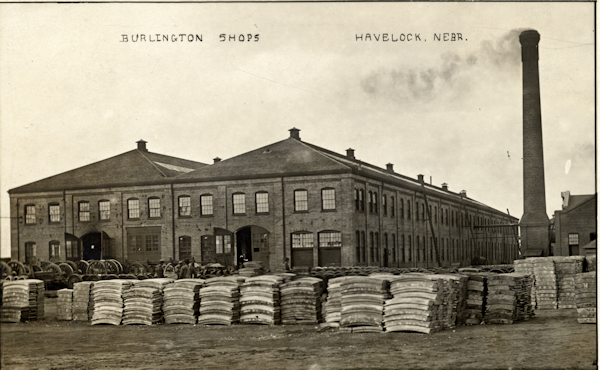
Before asking for help identifying the items I had to do my own research. I’ve learned a lot about the Burlington Shops. I still don’t know what those items are but I have some better guesses now. Before I share my guesses and ask for your help, let me tell you what I’ve learned about the Burlington Shops in Havelock.
The book
Lincoln: The Capital City and Lancaster County, Nebraska, Volume 1 (1916) provides a nice history of the town and the shops. The town of Havelock was incorporated on May 6, 1893. It was located about four
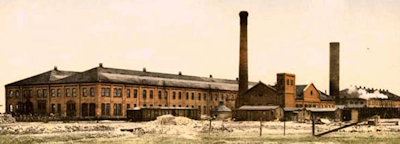
miles northeast of downtown Lincoln. Around the same time, Burlington decided to locate a repair and manufacturing shop in Havelock. Work on the first building started in June of 1890. A blacksmith shop, boiler shop and a new shop building were added a few years later. The next large expansion came 1910.
I was surprised by the amount of information I was able to find about the shops and expansion that took place around 1910. I found two journals articles published in 1911 that included detailed information about the Burlington Shops. At first glance, the articles may appear to be identical but they are slightly different. They contain too much information for me to include in this post but below are links to the articles along with few highlights.
Here are a few highlights from these articles.
 Both articles provide detailed drawings of the property that includes the location and dimensions of every building. I found it fun to compare the map to a current bird’s eye view of the shops. Many of the builds are still being used today.
Both articles provide detailed drawings of the property that includes the location and dimensions of every building. I found it fun to compare the map to a current bird’s eye view of the shops. Many of the builds are still being used today.- The newly built storehouse is 80 ft. wide, 500 ft. long, and three stories high. It is surrounded on three sides by a 16 ft. wide platform.
- On the west end of the storehouse, 100 ft. of space on the first and second floors was designed as office space. On the first floor were “quarters of the superintendent of shops and the storekeeper. On the second floor are the stationer, medical examiner with emergency hospital fully equipped, telephone exchange, space for apprentice school and meeting room.”
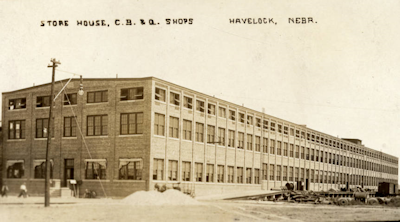
- The windows in the storehouse were designed to work with the material cases that would be stored in the building. “The material cases are 5 feet wide at the bottom and are separated by space of the same width. This arrangement gives a case spacing of 10 feet center to center and 7 feet of window between two adjacent cases, the tops of which are three feet wide.”
While both of these journal articles provided me with a ton of information, I still didn’t have any good guess about the objects in the photo. I thought they might be made out of cement because if you look at the bottom of a few of the stacks you can see that a few of them have broken.
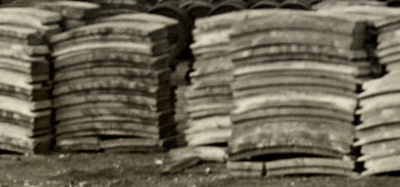
The article
A Modern Concrete Slab and Pile Plant appeared in the 1921 issue of R
ailway Track and Structures, Volume 17 confirms that there was a concrete plant at the Havelock shops. The article listed some of the items manufactured at the Havelock Shops. “In addition to the concrete slabs and piles, the concrete plant is equipped to manufacture concrete fence posts, platform curbs, hog troughs and some miscellaneous items.” Included with the article was a picture of concrete curb units but they do not match the items in the picture.
Now that you know a bit more about the Burlington Shops at Havelock, what do you think the items are piled in front of the boiler shop? If you haven’t already done so, take a minute and go
view the image on the Nebraska Memories website. You can use the zoom function to get a better view.
What do you think they are? As you can see, there are a few different items. I can pick out three different styles for sure.

At the far left, you can see three small piles. I think they are flat but they do have slight curve to them.

In the middle of the picture are items that have a slight arch to them. If you look at the bottom of the piles, you can see a significant gap between the middle of the items and the ground. As I mentioned before a few of them have broken. Do you think these and the first items are both curbs used on curves?
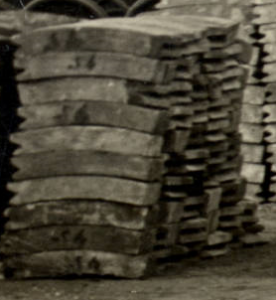
The items at the far right are much shorter. I think they have a slight arch to them. As I was looking at the picture of the roundhouse, I was wondering if these pieces could be used to line the turntable.
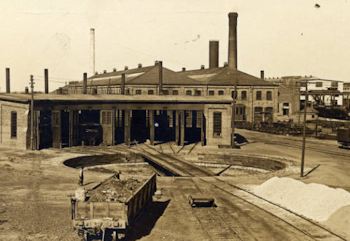
Do you agree with my guesses or am I completely off track? Are these pieces used in assembling a train engine? Leave me a comment and let me know what you think they are.
If you are interested in the Burlington shops, I found two additional historical journals articles that I read but didn’t reference in this post. I thought you might enjoy reading them.
Visit
Nebraska Memories to search for or browse through many more historical images digitized from photographs, negatives, postcards, maps, lantern slides, books and other materials.
Nebraska Memories is a cooperative project to digitize Nebraska-related historical and cultural heritage materials and make them available to researchers of all ages via the Internet. Nebraska Memories is brought to you by the Nebraska Library Commission. If your institution is interested in participating in Nebraska Memories, see
http://nlc.nebraska.gov/nebraskamemories/participation.aspx for more information, contact
Devra Dragos, Technology & Access Services Director.
 Before asking for help identifying the items I had to do my own research. I’ve learned a lot about the Burlington Shops. I still don’t know what those items are but I have some better guesses now. Before I share my guesses and ask for your help, let me tell you what I’ve learned about the Burlington Shops in Havelock.
The book Lincoln: The Capital City and Lancaster County, Nebraska, Volume 1 (1916) provides a nice history of the town and the shops. The town of Havelock was incorporated on May 6, 1893. It was located about four
Before asking for help identifying the items I had to do my own research. I’ve learned a lot about the Burlington Shops. I still don’t know what those items are but I have some better guesses now. Before I share my guesses and ask for your help, let me tell you what I’ve learned about the Burlington Shops in Havelock.
The book Lincoln: The Capital City and Lancaster County, Nebraska, Volume 1 (1916) provides a nice history of the town and the shops. The town of Havelock was incorporated on May 6, 1893. It was located about four  miles northeast of downtown Lincoln. Around the same time, Burlington decided to locate a repair and manufacturing shop in Havelock. Work on the first building started in June of 1890. A blacksmith shop, boiler shop and a new shop building were added a few years later. The next large expansion came 1910.
I was surprised by the amount of information I was able to find about the shops and expansion that took place around 1910. I found two journals articles published in 1911 that included detailed information about the Burlington Shops. At first glance, the articles may appear to be identical but they are slightly different. They contain too much information for me to include in this post but below are links to the articles along with few highlights.
miles northeast of downtown Lincoln. Around the same time, Burlington decided to locate a repair and manufacturing shop in Havelock. Work on the first building started in June of 1890. A blacksmith shop, boiler shop and a new shop building were added a few years later. The next large expansion came 1910.
I was surprised by the amount of information I was able to find about the shops and expansion that took place around 1910. I found two journals articles published in 1911 that included detailed information about the Burlington Shops. At first glance, the articles may appear to be identical but they are slightly different. They contain too much information for me to include in this post but below are links to the articles along with few highlights.
 Both articles provide detailed drawings of the property that includes the location and dimensions of every building. I found it fun to compare the map to a current bird’s eye view of the shops. Many of the builds are still being used today.
Both articles provide detailed drawings of the property that includes the location and dimensions of every building. I found it fun to compare the map to a current bird’s eye view of the shops. Many of the builds are still being used today.
 The article A Modern Concrete Slab and Pile Plant appeared in the 1921 issue of Railway Track and Structures, Volume 17 confirms that there was a concrete plant at the Havelock shops. The article listed some of the items manufactured at the Havelock Shops. “In addition to the concrete slabs and piles, the concrete plant is equipped to manufacture concrete fence posts, platform curbs, hog troughs and some miscellaneous items.” Included with the article was a picture of concrete curb units but they do not match the items in the picture.
Now that you know a bit more about the Burlington Shops at Havelock, what do you think the items are piled in front of the boiler shop? If you haven’t already done so, take a minute and go view the image on the Nebraska Memories website. You can use the zoom function to get a better view.
What do you think they are? As you can see, there are a few different items. I can pick out three different styles for sure.
The article A Modern Concrete Slab and Pile Plant appeared in the 1921 issue of Railway Track and Structures, Volume 17 confirms that there was a concrete plant at the Havelock shops. The article listed some of the items manufactured at the Havelock Shops. “In addition to the concrete slabs and piles, the concrete plant is equipped to manufacture concrete fence posts, platform curbs, hog troughs and some miscellaneous items.” Included with the article was a picture of concrete curb units but they do not match the items in the picture.
Now that you know a bit more about the Burlington Shops at Havelock, what do you think the items are piled in front of the boiler shop? If you haven’t already done so, take a minute and go view the image on the Nebraska Memories website. You can use the zoom function to get a better view.
What do you think they are? As you can see, there are a few different items. I can pick out three different styles for sure.
 At the far left, you can see three small piles. I think they are flat but they do have slight curve to them.
At the far left, you can see three small piles. I think they are flat but they do have slight curve to them.
 In the middle of the picture are items that have a slight arch to them. If you look at the bottom of the piles, you can see a significant gap between the middle of the items and the ground. As I mentioned before a few of them have broken. Do you think these and the first items are both curbs used on curves?
In the middle of the picture are items that have a slight arch to them. If you look at the bottom of the piles, you can see a significant gap between the middle of the items and the ground. As I mentioned before a few of them have broken. Do you think these and the first items are both curbs used on curves?
 The items at the far right are much shorter. I think they have a slight arch to them. As I was looking at the picture of the roundhouse, I was wondering if these pieces could be used to line the turntable.
The items at the far right are much shorter. I think they have a slight arch to them. As I was looking at the picture of the roundhouse, I was wondering if these pieces could be used to line the turntable.
 Do you agree with my guesses or am I completely off track? Are these pieces used in assembling a train engine? Leave me a comment and let me know what you think they are.
If you are interested in the Burlington shops, I found two additional historical journals articles that I read but didn’t reference in this post. I thought you might enjoy reading them.
Do you agree with my guesses or am I completely off track? Are these pieces used in assembling a train engine? Leave me a comment and let me know what you think they are.
If you are interested in the Burlington shops, I found two additional historical journals articles that I read but didn’t reference in this post. I thought you might enjoy reading them.

